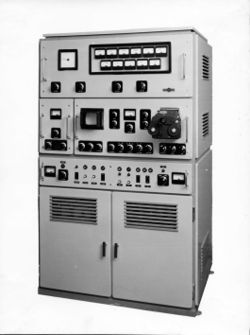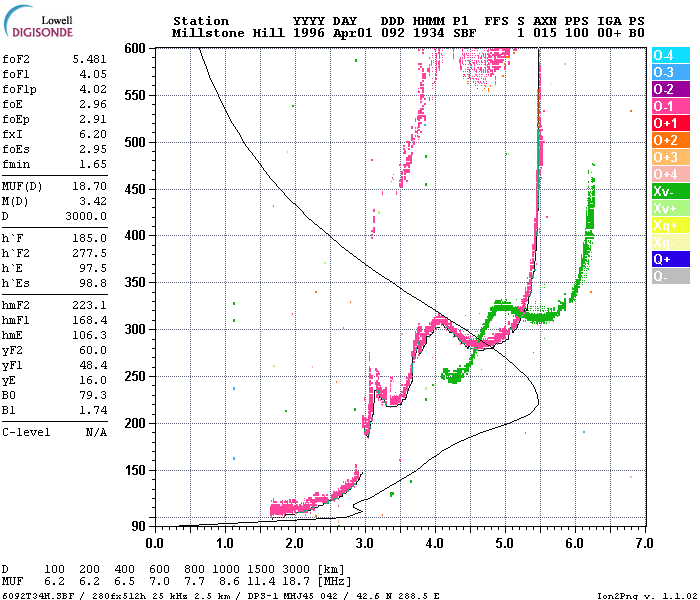Ionosonde
From HFUnderground
| Line 1: | Line 1: | ||
{{Work In Progress}} | {{Work In Progress}} | ||
| - | [[ | + | [[Image:IRX-58-23-ionosonde.jpg|250px|thumb|right|An IRX-58-23 ionosonde system.]] |
| - | A '''ionosonde''', or '''chirpsounder''', is a special [[radar]] for the examination of the [[ionosphere]]. An ionosonde consists of: | + | A '''ionosonde''', or '''chirpsounder''', is a special [[radar]] for the examination of the [[ionosphere]]. |
| + | |||
| + | ==Description== | ||
| + | |||
| + | An ionosonde consists of: | ||
* A [[high frequency]] (HF) transmitter, automatically tunable over a wide range. Typically the frequency coverage is 0.5–23 MHz or 1–40 MHz, though normally sweeps are confined to approximately 1.6–12 MHz. | * A [[high frequency]] (HF) transmitter, automatically tunable over a wide range. Typically the frequency coverage is 0.5–23 MHz or 1–40 MHz, though normally sweeps are confined to approximately 1.6–12 MHz. | ||
| Line 10: | Line 14: | ||
The transmitter sweeps all or part of the HF frequency range, transmitting short pulses. These pulses are reflected at various layers of the ionosphere, at heights of 100–400 km, and their echos are received by the receiver and analyzed by the control system. The result is displayed in the form of an [[ionogram]], a graph of reflection height (actually time between transmission and reception of pulse) versus carrier frequency. | The transmitter sweeps all or part of the HF frequency range, transmitting short pulses. These pulses are reflected at various layers of the ionosphere, at heights of 100–400 km, and their echos are received by the receiver and analyzed by the control system. The result is displayed in the form of an [[ionogram]], a graph of reflection height (actually time between transmission and reception of pulse) versus carrier frequency. | ||
| - | + | [[Image:Ionogram.png|center]] | |
| - | The basic ionosonde technology was invented in 1925 by | + | The basic ionosonde technology was invented in 1925 by Gregory Breit and Merle A. Tuve <ref name="Judd1988">{{cite book|publisher=Heinemann|title=Radio Wave Propagation (HF Bands)|author=F.C. Judd, G2BCX|year=1987|location=London|isbn=0-434-90926-2|pages=12–20,27–37}}</ref> and further developed in the late 1920s by a number of prominent physicists, including Edward Victor Appleton. The term ''[[ionosphere]]'' and hence, the etymology of its derivatives, was proposed by Robert Watson-Watt. |
An ionosonde is used for finding the optimum operation frequencies for broadcasts or two-way communications in the high frequency range. | An ionosonde is used for finding the optimum operation frequencies for broadcasts or two-way communications in the high frequency range. | ||
Revision as of 14:52, 5 September 2010
 | This article or section is under construction. |
A ionosonde, or chirpsounder, is a special radar for the examination of the ionosphere.
Contents |
Description
An ionosonde consists of:
- A high frequency (HF) transmitter, automatically tunable over a wide range. Typically the frequency coverage is 0.5–23 MHz or 1–40 MHz, though normally sweeps are confined to approximately 1.6–12 MHz.
- A tracking HF receiver which can automatically track the frequency of the transmitter.
- An antenna with a suitable radiation pattern, which transmits well vertically upwards and is efficient over the whole frequency range used.
- Digital control and data analysis circuits.
The transmitter sweeps all or part of the HF frequency range, transmitting short pulses. These pulses are reflected at various layers of the ionosphere, at heights of 100–400 km, and their echos are received by the receiver and analyzed by the control system. The result is displayed in the form of an ionogram, a graph of reflection height (actually time between transmission and reception of pulse) versus carrier frequency.
The basic ionosonde technology was invented in 1925 by Gregory Breit and Merle A. Tuve <ref name="Judd1988">Template:Cite book</ref> and further developed in the late 1920s by a number of prominent physicists, including Edward Victor Appleton. The term ionosphere and hence, the etymology of its derivatives, was proposed by Robert Watson-Watt.
An ionosonde is used for finding the optimum operation frequencies for broadcasts or two-way communications in the high frequency range.
An ionogram is a display of the data produced by the ionosonde. It is a graph of the virtual height of the ionosphere plotted against frequency. Ionograms are often converted into electron density profiles. Data from ionograms may be used to measure changes in the Earth's ionosphere due to space weather events.
See also
References
Further reading
External links
- http://www.ngdc.noaa.gov/ionosonde/ : NOAA Ionosonde portal to information and data services
- http://www.ngdc.noaa.gov/stp/IONO/Dynasonde/ : NOAA Dynasonde: Real-time Ionospheric Explorer by advanced and prototype analysis methods.
- http://aintel.bi.ehu.es/chirps-data/chirps.html
- http://ulcar.uml.edu/digisonde.html : Lowell Center for Atmospheric Research, MA, USA
- http://ulcar.uml.edu/stationlist.html : Ionosonde (partial) station list by location
- http://www.iono.noa.gr : National Observatoy of Athens, Greece
- http://www.sil.sk.ca/cadi.html : Canadian Advanced Digital Ionosonde (CADI)
This site is a participant in the Amazon Services LLC Associates Program, an affiliate advertising program designed to provide a means for sites to earn advertising fees by advertising and linking to Amazon.com. Some links may be affiliate links. We may get paid if you buy something or take an action after clicking one of these.

